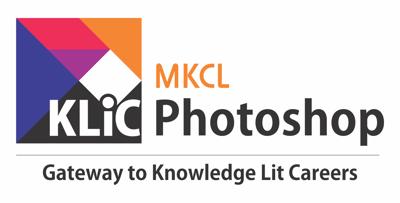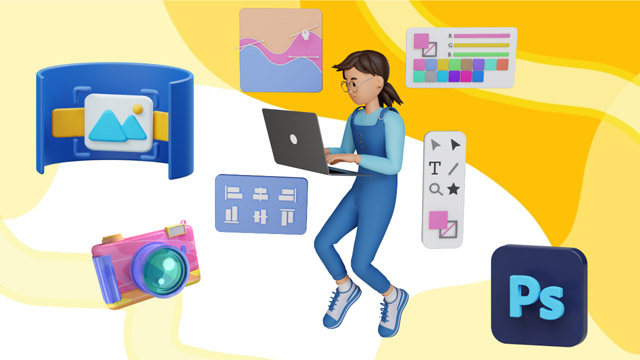- In this course, you will learn to:
- Explain the essence and scope of photography as a medium of artistic expression and communication
- Identify and explain fundamental photography principles to enhance visual storytelling
- Operate a camera effectively, utilizing its basic functions and settings
- Differentiate various photography styles and genres to broaden artistic perspective
- Identify potential career paths in photography and understand the business aspects of the profession
- Rate mobile photography techniques and tools to capture high-quality images
- Create a compelling photography portfolio that showcases individual style and skills
- Explain the fundamentals of photo editing to enhance and refine images
- Identify popular photo editing tools and their applications in image enhancement
- Demonstrate use of a popular photo editing tools
- Explain digital artistry techniques using Photoshop to create visually striking images
- Organize and save files, ensuring workflow efficiency and data management
- Identify advanced Photoshop techniques to expand creative possibilities in editing
- Classify photo adjustments and corrections to improve image quality
- Identify and master advanced photo editing tools like layers, masks, and filters.
- Describe the concepts of layers, blending modes, and non-destructive editing with masks.
- Identify and discuss various masking techniques for precise editing.
- Organize the creation of cohesive montages and composites.
- Compare and examine the application of artistic filters for creative balance.
- Explain the non-destructive editing approach and its flexibility.
- Predict and estimate the advantages of working with RAW files and advanced processing.
- Differentiate and examine portrait retouching techniques for natural and professional results.
- Summarize the approach to handling diverse projects to build a versatile portfolio.
- Find valuable insights through market research to refine your digital marketing strategies.
- Arrange and explain the process of optimizing workflow and addressing common editing challenges.
- Classify different types of raw files and their respective features and limitations
- Explain the benefits of shooting in raw format compared to JPEG
- Identify the steps involved in importing and processing raw images in editing software
- Explore advanced raw editing techniques for optimal image quality
- Identify the benefits of batch processing and automation in raw file editing
- Explain specialized editing techniques for various types of photography such as landscape, portrait, and product
- Compare traditional photo editing methods with HDR techniques for achieving high dynamic range
- Analyze the process and outcomes of specialized editing case studies
- Demonstrate the operation of different tools within editing software to maximize the impact of raw files
- Assess the images using advanced editing techniques to address specific challenges like high ISO noise
- Recognize the best practices in creating HDR images, from capturing to editing
- Identify different editing techniques and choose the most effective based on the scenario
- Examine strategies for cleaning and enhancing product photographs for commercial use
- Differentiate between editing methods for print and web, ensuring optimal results for each medium
- Construct comprehensive editing strategies that incorporate a range of techniques and tools for diverse photographic scenarios

Be a PhotoFix Pro
Enhance and retouch images professionally with precision and creative flair.
Introduction
What you'll learn ?
- At the end of this course, learners will be able to:
- Apply basic principles of photography to capture aesthetically pleasing photographs
- Illustrate the use of key photography principles in creating visually compelling images
- Create and implement effective methods for operating camera equipment in different scenarios
- Compare and contrast a variety of photography styles and genres
- Utilize mobile technology to enhance photography skills
- Create a professional photography portfolio
- Identify various career paths in the field of photography
- Differentiate among popular photo editing tools and their uses
- Utilize Adobe Photoshop to edit and enhance photos
- Create a workflow in Adobe Photoshop for efficient photo editing
- Combine techniques in Adobe Photoshop for basic to advanced photo editing tasks
- Experiment with advanced editing techniques to expand artistic expression
- Implement essential photo corrections like exposure, color, and composition in their photographs
- Interpret and recognize advanced photo editing tools like layers, masks, and filters.
- Illustrate the effective usage of photo editing tools through comprehensive tutorials.
- Transform editing capabilities by experimenting with advanced non-destructive techniques.
- Defend the importance of practicing and elevating editing skills.
- Paraphrase the concept of layers in photo editing and their significance.
- Recall techniques for working with multiple layers and understanding blending modes.
- Explain the practical uses of layers for organizing and manipulating image elements.
- Describe how layer masks enable non-destructive editing and selective adjustments.
- Differentiate various masking techniques, including manual and gradient masking.
- Distinguish the control masks offer for precise editing and creativity.
- Support the achievement of unified and visually appealing results through colour harmonization.
- Review raw file types detailing features and limitations
- Interpret benefits of raw format over JPEG emphasizing post-processing advantages
- Identify steps for importing and processing raw images in editing software
- Make use of advanced raw editing techniques to enhance image quality
- Interpret batch processing and automation advantages in raw editing workflows
- Compare traditional editing and HDR techniques for dynamic range improvement
- Report outcomes from specialized editing technique applications in case studies
- Examine tool use within editing software to optimize raw images for enhanced quality and visual impact
- Identify images with advanced techniques to correct high ISO noise
- Formulate best practices for HDR image creation from capture to editing
- Examine strategies for enhancing commercial quality product photographs
- Compare editing methods for print versus web for optimal result
- Construct comprehensive strategies incorporating diverse techniques for varied contexts
Certification
- KLiC courses are recognised by Yashwantrao Chavan Maharashtra Open University (YCMOU).
- MKCL provides certificate to the KLiC learner after his/her successful course completion.
- Yashwantrao Chavan Maharashtra Open University (YCMOU) provides mark sheet to successfully passed KLiC learners (Jurisdiction: Maharashtra).
Academic Approach
The academic approach of the courses focuses on the “work-centric” education i.e. begin with work (and not from a book!), derive knowledge from work and apply that knowledge to make the work more wholesome, useful and delightful. The ultimate objective is to empower the Learner to engage in socially useful and productive work. It aims at leading the learner to his/her rewarding career as an employee or entrepreneur as well as development of the community to which s/he belongs. Learning methodology:
- Step -1: Learners are given an overview of the course and its connection to life and work.
- Step -2: Learners are exposed to the specific tool(s) used in the course through the various real-life applications of the tool(s).
- Step -3: Learners are acquainted with the careers and the hierarchy of roles they can perform at workplaces after attaining increasing levels of mastery over the tool(s).
- Step -4: Learners are acquainted with the architecture of the tool or tool map so as to appreciate various parts of the tool, their functions, utility and inter-relations.
- Step -5: Learners are exposed to simple application development methodology by using the tool at the beginner’s level.
- Step -6: Learners perform the differential skills related to the use of the tool to improve the given ready-made industry-standard outputs.
- Step -7: Learners are engaged in appreciation of real-life case studies developed by the experts.
- Step -8: Learners are encouraged to proceed from appreciation to imitation of the experts.
- Step -9: After the imitation experience, they are required to improve the expert’s outputs so that they proceed from mere imitation to emulation.
- Step-10: Emulation is taken a level further from working with differential skills towards the visualization and creation of a complete output according to the requirements provided. (Long Assignments)
- Step-11: Understanding the requirements, communicating one’s own thoughts and presenting are important skills required in facing an interview for securing a work order/job. For instilling these skills, learners are presented with various subject-specific technical as well as HR-oriented questions and encouraged to answer them.
- Step-12: Finally, they develop the integral skills involving optimal methods and best practices to produce useful outputs right from scratch, publish them in their ePortfolio and thereby proceed from emulation to self-expression, from self-expression to self-confidence and from self-confidence to self-reliance and self-esteem!
Syllabus
Evaluation Pattern
Evaluation Pattern of KLiC Courses consists of 4 Sections as per below table:
| Section No. | Section Name | Total Marks | Minimum Passing Marks |
|---|---|---|---|
| 1 | Learning Progression | 25 | 10 |
| 2 | Internal Assessment | 25 | 10 |
| 3 | Final Online Examination | 50 | 20 |
| Total | 100 | 40 | |
| 4 | SUPWs (Socially Useful and Productive Work in form of Assignments) | 5 Assignments | 2 Assignments to be Completed & Uploaded |
YCMOU Mark Sheet
Printed Mark Sheet will be issued by YCMOU on successful completion of Section 1, Section 2 and Section 3 and will be delivered to the learner by MKCL.
YCMOU Mark Sheet will be available only for Maharashtra jurisdiction learners
MKCL's KLiC Certificate
The certificate will be provided to the learner who will satisfy the below criteria:
- Learners who have successfully completed above mentioned 3 Sections i.e. Section 1, Section 2 and Section 3
- Additionally, learner should have completed Section 4 (i.e. Section 4 will comprise of SUPWs i.e. Socially Useful and Productive Work in form of Assignments)
- Learner has to complete and upload minimum 2 out of 5 Assignments
Courses Fee Structure from 01 July, 2025 Onwards
KLiC 90 hour course fee applicable from 01 July, 2025 all over Maharashtra
| KLiC Course Duration | MFO (Inclusive of GST) |
ALC Share (Service Charges to be collected by ALC) |
|---|---|---|
| 90 hours | Rs. 750/- | Rs. 4,000/- |
* Above mentioned fee is applicable for all Modes of KLiC Courses offered at Authorised Learning Center (ALC) and at Satellite Center
* Total fee is including of Course fees, Examination fees and Certification fees
* MKCL reserves the right to modify the Fee anytime without any prior notice
